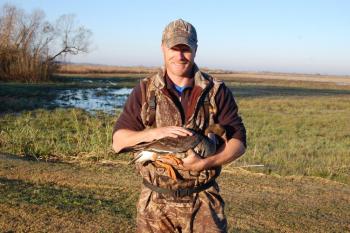
Paul Link, Louisiana Department of Wildlife and Fisheries’ North American Waterfowl Management plan coordinator, holds a banded specklebelly goose. The department is studying habitat use, movements, immigration and emigration, fidelity to wintering areas of specklebellies. (Photo by Claudette Olivier)
Less speckbelly geese in Louisiana may lead to shorter season
By: CLAUDETTE OLIVIER
LSN Newspapers
They fly by your house, and they honk.
No, they aren’t friends and neighbors greeting you as they travel on your street — they are migrating geese.
Of the species of geese that midwinter in Louisiana, specklebellies are visiting the state in dwindling numbers.
Paul Link, Louisiana Department of Wildlife and Fisheries’ North American Waterfowl Management plan coordinator, said, “We have a fairly small population of resident giant Canada geese and a declining trend in migratory Tall Grass Prairie Canada geese. White geese — snow, blue, Ross’ — are also declining here despite increases range-wide. White-fronts (specklebellies) migrate here one to two months earlier and stay (about) one month longer in the spring than TGP Canadas and white geese.”
Specklebellies or white-fronted geese are often spotted in rice lakes in the Tri-Parish area at this time of the year, but even with an increase in the Midcontinent white-front population, wintering counts, conducted during the first two weeks in January have declined in the state in the last two decades.
“It’s not a breeding problem,” Link said. “The population is actually growing. It’s doing really well.”
According to survey data from the U.S. Fish and Wildlife service, an average of 32 percent of Midcontinent white-fronted geese now winter in Louisiana compared to 80 percent 20 years ago. In 1995, estimates put the number of specklebellies in Louisiana at 91,200, and the 2015 estimate was 58,850. Mid-wintering specklebelly numbers have been recorded in Lousiana since 1955, and the survey number peaked in 1998 with an estimated 149,678 birds. The lowest midwinter survey on record was 4,000 birds in 1957.
In 1995, there were an estimated 134,421 specklebellies in the Mississippi Flyaway, and Louisiana, Ohio, Kentucky, Arkansas and Mississippi were the only other states in the flyway that observed birds. In 2015, those same states, along with Illinois, Indiana, Missouri, Tennessee and Alabama all observed specklebellies. Arkansas saw the most birds with an estimated 183,282 specklebellies
“Most southern states are counting more white-fronts,” Link said. “Arkansas sees the most.”
Changes in agriculture, hurricanes and increased urbanization and industrialization in historic goose habitats, especially in Cameron, Calcasieu and Vermillion parishes, are changing Louisiana’s landscape and the places where geese midwinter. Link said he suspects the combination of declining habitat quality and quantity and increased hunting pressure are the two main reasons behind lower mid-wintering specklebelly numbers.
“Birds will tolerate substantially more disturbance when utilizing high quality habitats than low quality habitats,” Link said.
With fewer specks heading to the state, the department is rethinking the specklebelly hunting season structure. When the discussion of season changes arose late last summer, guides who attended the August Louisiana Wildlife and Fisheries Commission meeting did not want an increased bag limit on specks, which would have been allowed by the federal season framework, and the commission chose to go with an 81-day season with only two white-fronted geese per day for the 2015-16 season. At its January meeting, the commission proposed 2016-17 season dates of Nov. 12-Dec. 4 and Dec. 17-Feb. 12 for both the state’s north and south zones. Hunters could have fewer days to target specklebellies than federal framework allows, but the bag limit would remain two per hunter.
Hunters may comment on the proposed goose regulations at any of the next three commission meetings or at public forums that will be held across the state in late February. The closest meeting to the Tri-Parish area will be at 6 p.m. Feb. 24 at the Louisiana Ecological Services Field Office in Lafayette. Comments may also be submitted to Steve Smith at ssmith@wlf.la.gov or Steve Smith, LDWF Wildlife Division, P.O. Box 98000, Baton Rouge, LA 70898-9000.
In the mean time, Link is studying the sources behind of the falling number of specklebellies overwintering in the state, and the data gathered could be used for future management and hunting regulation decisions.
“Basic information such as diurnal and nocturnal habitat use, movements, immigration and emigration, fidelity to wintering areas, etc. is currently lacking,” Link said. “These data are obviously important when considering management and regulatory decisions. For instance, learning when white-fronts arrive and depart Louisiana could help guide season dates to coincide with the greatest numbers of birds.”
Link shared what is already known of white-fronted goose habitat use in the state and the birds’ movements in and out of the state.
“They primarily use rice, fallow pasture, soybeans and fresh marsh,” Link said. “They appear to identify safe nocturnal roost sites and do multiple foraging flights per day to various locations, often returning to the same roost for the night.”
Rice agriculture is most important to geese mid-wintering in Louisiana, Link said, and he noted the decline in rice agriculture in the state.
“There is now more rice agriculture in Arkansas than there was 10 years ago,” he said. “It’s a pretty simple assumption, but we may find that this (lower rice acreage in the state) is not the case. It’s too early in the study. It has been our assumption for the last few years, but the study will hopefully provide the data necessary.”
Link and his student workers caught 79 white-fronts during last October and November at the Southwest Louisiana National Wildlife Refuge Complex and on private property near Bell City and Thornwell, Link said. Link plans to tag more birds in the same areas this fall.
“They (specks) are very smart and cautious of anything out of the ordinary,” Link said. “They prefer wide-open fields and don’t often associate with field edges, levees, or other vegetation that affords hiding trapping equipment. They don’t easily come to bait, and we weren’t allowed to try baiting due to federal baiting regulations during open hunting seasons.
“Thus, I had to extensively scout for particular places birds were frequenting where I could hide rocket nets, then meticulously hide everything; even being careful to not leave boot prints behind. Then being extremely patient, sometimes waiting multiple days in a row for birds to simply wander too close to a set.”
All of the geese were leg-banded. Eleven adults were fitted with the transmitter units. Data is being collected from the birds, and Link said there is great variation among the birds and their individual travels.
“A couple remain within a 50 mile radius of their capture sites, and others have logged greater than 2,000 miles across five states,” he said. “Overall, we’re very surprised at how much they have moved thus far. I recovered one transmitter near Brinkley, Arkansas, that we suspect was unretrieved by a hunter. Three birds that were captured and leg banded along with the birds we radiomarked have been shot and reported by hunters.
“It appears as though the onset of hunting season caused the initial exodus from Southwest Louisiana. Since then I haven’t seen any single event move multiple birds at once.”
Hunters who harvest one of the geese with a transmitter are asked to contact Link and turn in the unit for use on another goose. The department will exchange a replica non-working transmitter as a keepsake for the hunter.
- Log in to post comments

